Georgia’s local governments aligned closely with the federal government’s system of immigration enforcement over the past decade, especially in some rapidly diversifying counties around metro Atlanta. Beyond adhering to mandatory federal laws, this includes embracing voluntary practices designed solely to maximize arrests and deportations of unauthorized immigrants for infractions as minor as traffic violations. These policies carry significant social costs for families and communities, especially in the long-run due to extreme psychological and socioeconomic harm they inflict on children. They also impose some concrete budget costs on local governments. Though precise numbers on the subject are scarce, some informed estimates on the direct financial cost to Georgia’s local governments of voluntary immigration enforcement are possible. This report finds:
- Honoring federal detainers, non-binding requests from Immigration and Customs Enforcement (ICE) to arrest and hold a person, cost Georgia’s local governments an estimated $88 million over the past decade, or about $9 million a year statewide on average. These costs stem from the fact that people with detainer requests are more likely to be held in custody rather than ticketed and released for minor offenses. They also tend to remain in jail for longer than people without detainers, since ICE often fails to promptly pick them up.
- Additional costs accrue in counties with so-called 287(g) agreements, which deputize local officers to do the work of federal immigration agents. Georgia’s Cobb, Gwinnett, Hall and Whitfield counties have operated 287(g) programs for several years. Bartow and Floyd counties recently signed on as well. Many local governments cannot provide detailed budget figures on the costs of immigration enforcement, according to open records requests.[1] But available evidence suggests the financial price is substantial. Gwinnett County budget documents show its 287(g) program costs local taxpayers at least $9.8 million over eight years from its inception in 2009 through 2016, an average of $1.2 million a year. Adding in the Gwinnett-specific cost of honoring detainers inflates the county’s overall cost of enforcement to as much as $3.7 million a year.
- Most local expenses for immigration enforcement are not reimbursed. Georgia’s local governments only recovered an estimated 12 percent of the cost of imposing detainers over a nine-year span from 2008 to 2016, according to GBPI analysis of federal grants. The rate is likely lower in 287(g) counties due to additional non-reimbursable costs resulting from that program. In Gwinnett County, local officials recovered no more than 10 percent of the cost for its 287(g) program since launching it in 2009, and potentially as little as 3 percent of the total price of aggressive enforcement.
The true cost to local governments also likely exceeds these estimates long-term, due to the considerable social and economic harm that indiscriminate enforcement causes in immigrant communities, especially for children. And while aggressive enforcement policies are often justified under the guise of protecting public safety, available evidence indicates that an overly harsh approach may do as much to undermine that goal as help it. Moving forward, lawmakers considering how best to approach the question of immigration can carefully weigh the financial, economic and social costs of aggressive enforcement against supporters’ unproven claims.
Background
Questions surrounding the nation’s immigration policies and the appropriate role for state and local governments are a mainstay of U.S. politics. Immigration drew increased attention in Georgia starting in the 1990s, when people from Latin America, Asia and elsewhere started arriving in the Peach State in large numbers. Only about one in every 37 Georgians in 1990 was born outside the United States, compared to one in every 10 Georgians today.[2] Of the roughly 1 million immigrants who call Georgia home, an estimated 377,000 are undocumented.[3] An estimated 84 percent of unauthorized Georgians have lived in the United States for at least 5 years and about 60 percent have been here for 10 years or more.[4]
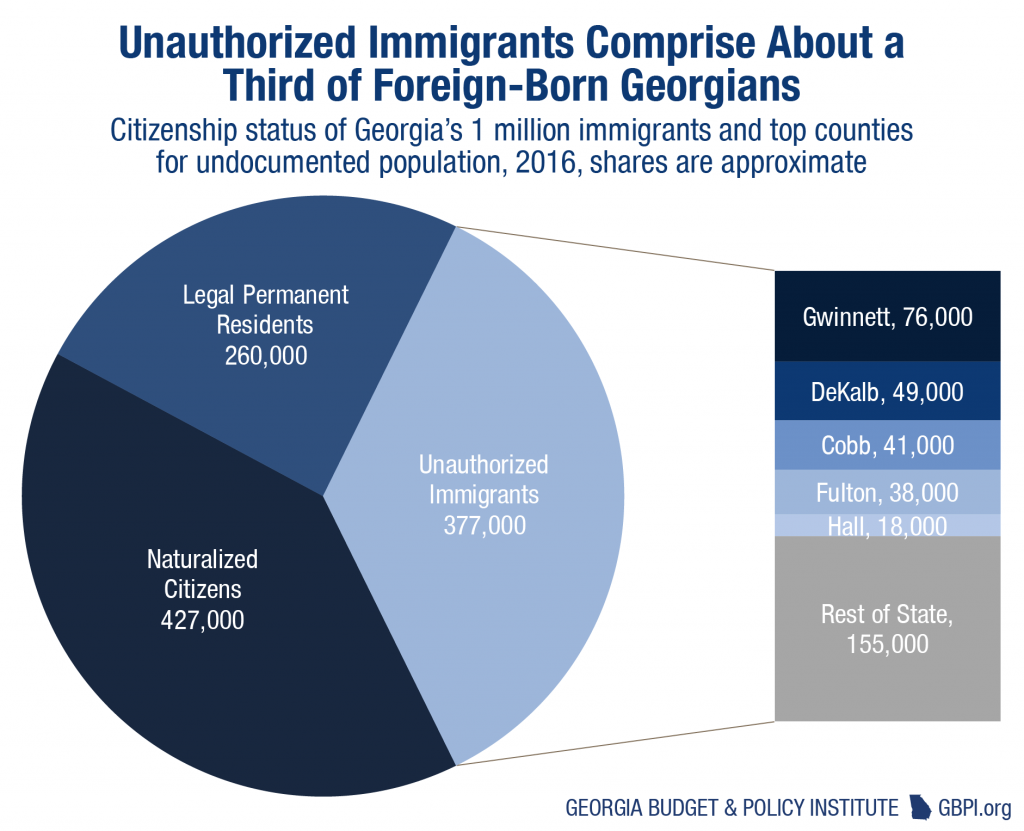
The modern federal enforcement apparatus dates mostly to 2003, when parts of several agencies were merged to create ICE to deal with immigration matters inside the country’s borders.[5] Detentions and deportations did not change much at first but surged in the late-2000s, due to increased migration to the U.S. leading up to those years, heightened involvement by local governments and other factors.[6]
Immigration removals peaked in the early years of the Obama Administration, then fell sharply during his second term. After Congress repeatedly failed to enact some version of comprehensive immigration reform, the Obama team instructed ICE to focus on specific categories of people such as violent criminals and more recent arrivals, while excluding some groups such as Dreamers, or young immigrants brought to the country as children.[7]
 Large-scale detention and indiscriminate removal of unauthorized immigrants regardless of individual circumstances sprang back into motion with the election of President Trump. During the first eight months of his administration, the number of ICE arrests nationwide spiked by 42 percent and deportations increased by 37 percent over the same period the previous year, according to the Migration Policy Institute.[8] The uptick is particularly stark in the South. In ICE’s Atlanta region, which includes Georgia, North Carolina and South Carolina, arrests of immigrants with no criminal record more than tripled in President Trump’s first year from 1,050 to 4,440, the largest regional increase in the country.[9]
Large-scale detention and indiscriminate removal of unauthorized immigrants regardless of individual circumstances sprang back into motion with the election of President Trump. During the first eight months of his administration, the number of ICE arrests nationwide spiked by 42 percent and deportations increased by 37 percent over the same period the previous year, according to the Migration Policy Institute.[8] The uptick is particularly stark in the South. In ICE’s Atlanta region, which includes Georgia, North Carolina and South Carolina, arrests of immigrants with no criminal record more than tripled in President Trump’s first year from 1,050 to 4,440, the largest regional increase in the country.[9]
Introduction to Voluntary State and Local Immigration Tools
The process of U.S. immigration enforcement is a complicated web of overlapping roles and responsibilities for federal, state and local jurisdictions. Federal immigration agents are generally free to enter and operate within local communities whenever and however they see fit, for activities such as neighborhood raids or removing high-priority people from workplaces or other locations.[10] State and local governments meanwhile must carry out certain mandatory requirements, such as scanning the fingerprints of all individuals upon arrest through the federal Secure Communities program.[11] But two additional widespread practices at the core of state and local enforcement are purely voluntary. The first is honoring immigration detainers, or non-binding hold requests from ICE. The second is adopting the hand-in-glove 287(g) partnership agreements with ICE, which train and deputize local law enforcement to carry out immigration tasks within local jails at their own expense.
Detainers
When federal immigration agents want to take custody of someone arrested by local law enforcement, a detainer request plays a key role in the process. Detainers are non-binding requests from ICE to the local law enforcement agency with custody of the people in question to arrest and hold them for up to 48 business hours beyond the time they otherwise would have been released, such as in the case of posting bail or having minor charges dropped. Federal court rulings have held that detainers are completely voluntary and that state and local officers can decide when to honor the requests and under what circumstances.[12]
Immigrants can be subject to detainers for minor infractions such as traffic violations or, under current ICE policy, simply for entering the U.S. without sufficient papers. Reports also indicate that ICE often files detainer requests for lawful permanent residents it suspects may be deportable and occasionally files them against U.S. citizens, sometimes due to name errors in federal databases—mistakes that have led to costly lawsuits for local governments in the past.[13] Detainers do not automatically result in deportation, and recent evidence indicates ICE often fails to follow up on them, extending immigrants’ length of stay at local jails.[14]
287(g) Agreements
A second tool available to local governments is the 287(g) program, which deputizes state and local officials to perform the functions of federal immigration agents. Though signed into law by President Clinton in 1996, the program remained little-used until the late 2000s, when a wave of communities signed up for it nationwide.[15] Cobb, Gwinnett, Hall and Whitfield joined the program from 2007 to 2009 and continue to participate today.[16] President Trump called for more local governments to join when he took office in January 2017, and 47 of the 76 current 287(g) agreements took effect after his inauguration.[17] Among the new entrants to the program are two additional Georgia counties, Bartow and Floyd, as well as the state’s Department of Corrections.[18]
Until 2012, many localities used the 287(g) program to implement aggressive enforcement within neighborhoods and the broader community, typically through the use of frequent traffic stops.[19] But federal officials terminated this so-called task force component of 287(g), due to continued controversy over possible racial profiling and other misuse.[20] Today, local police officers are permitted to perform immigration duties only within city and county jails. Tasks include interviewing individuals in custody about their immigration status, checking federal databases and physically transporting noncitizens into ICE custody.[21] Participating local officers receive periodic training from federal officials, and ICE agents at local jails supervise the process.
Detaining People with Immigration ‘Holds’ Carries Cost Statewide
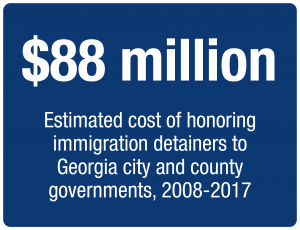 The use of immigration detainers in Georgia in the past decade ebbed and flowed in tandem with shifts in the federal approach to immigration. The practice of issuing detainers for immigrant removal spiked during the period of aggressive enforcement in Obama’s first term, peaking in 2011 and 2012 when more than 13,000 were issued annually statewide. Requests to Georgia’s local governments dropped sharply during Obama’s second term, when his administration pivoted from blanket enforcement toward a targeted effort focused on violent criminals and other high-priority categories such as newer arrivals. Detainers in Georgia jumped back up to nearly 6,300 in 2017, following the shift to indiscriminate enforcement by the Trump Administration.[22]
The use of immigration detainers in Georgia in the past decade ebbed and flowed in tandem with shifts in the federal approach to immigration. The practice of issuing detainers for immigrant removal spiked during the period of aggressive enforcement in Obama’s first term, peaking in 2011 and 2012 when more than 13,000 were issued annually statewide. Requests to Georgia’s local governments dropped sharply during Obama’s second term, when his administration pivoted from blanket enforcement toward a targeted effort focused on violent criminals and other high-priority categories such as newer arrivals. Detainers in Georgia jumped back up to nearly 6,300 in 2017, following the shift to indiscriminate enforcement by the Trump Administration.[22]
The annual cost to Georgia’s local governments fluctuated with the different detention approaches. It peaked at an estimated $18 million in 2011 and 2012, then fell as detentions and removals decreased during Obama’s later years. It accelerated again after President Trump’s inauguration to an estimated $8.3 million in 2017. This report estimates that holding people based on ICE detainer requests cost Georgia’s local governments on the whole an estimated $88 million from 2008 to 2017, or about $9 million a year statewide on average over a decade.
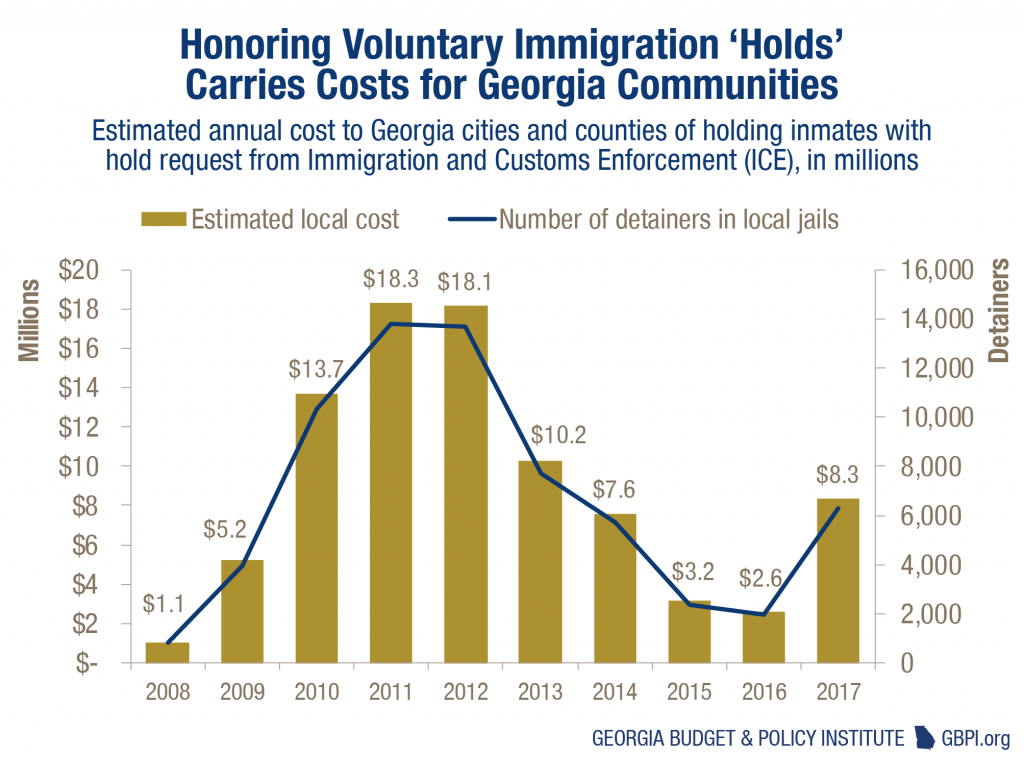
These costs are in line with similar estimates experts generated in other states, relative to each state’s population size and number of immigrants. In Texas, the state’s corrections department said it cost local jails $71 million statewide in 2017 to hold people on federal immigration detainers.[23] In Colorado, where a 2011 law required local governments to honor detainer requests, an independent 2012 report pegged the price at $13 million a year.[24] And a 2013 review of Washington state found that detainers cost an estimated $3 million a year.[25]
Why Does Complying with Detainers Incur Costs for Local Governments?
Honoring voluntary detainer requests can cost city and county governments money for two reasons. First, detainers often cause people who commit minor offenses such as driving without a license to be arrested and held in jail for an extended period, rather than simply ticketed and released.[26] This drives up local detention costs. In Hall County, for example, the sheriff’s department arrested and transferred to ICE 98 unauthorized immigrants for minor traffic violations over a four-month period in early 2017, according to an open records request. These individuals accounted for 54 percent of the people Hall County transferred to ICE over that span.[27]
Second, detainers usually cause unauthorized immigrants to remain in jail for longer than similarly situated people who have lawful presence in the U.S. Immigrants held on detainers often stay in jail for the duration of the pre-trial period, while U.S. citizens in the same position are typically released on bond. In Travis County, Texas, immigrants with a detainer stayed in jail three times longer than other individuals in custody, according to one study.[28] In California, immigrants with detainers remained incarcerated for an additional 20 days.[29] A similar review in Colorado[30] pegged the typical extra length of stay at 22 and a Washington state study found a 29-day extension.[31]
Only Small Share of Detainer Costs are Reimbursed
Since the 1990s, the federal government sought to offset some of the local cost of immigration enforcement through the State Criminal Alien Assistance Program (SCAAP), which provides grants to some city and county governments. But not all local governments receive the grants, and the dollar amounts typically fall short of the likely true cost of participating.[32] Georgia’s local governments only recovered an estimated 12 percent of the cost of honoring detainers over a nine-year span from 2008 to 2016, the most recent years available.
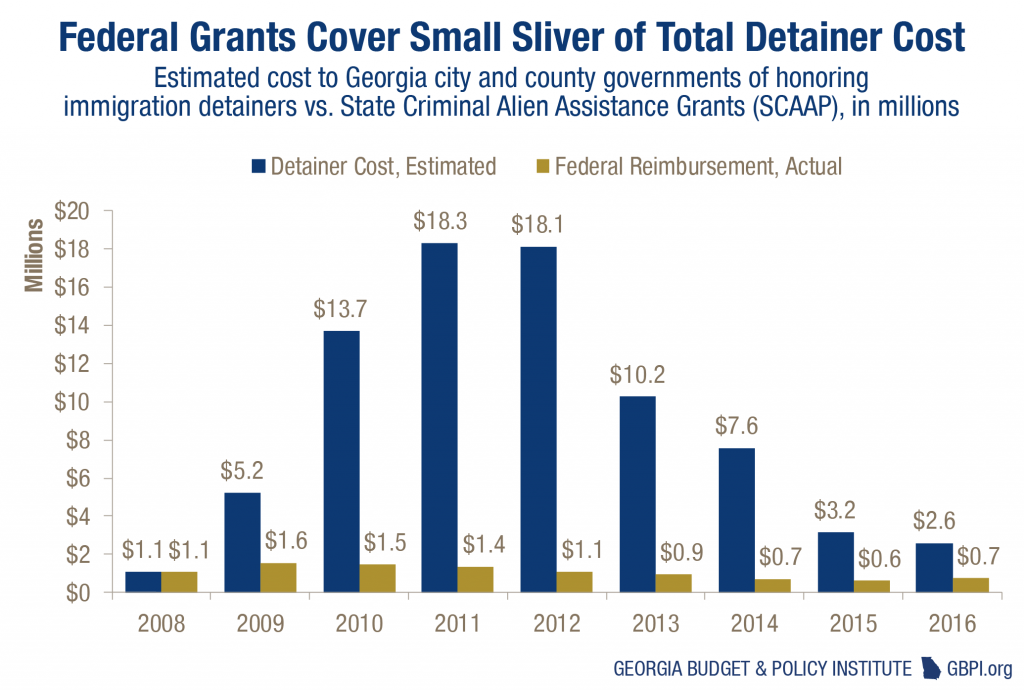
Counties with 287(g) Programs Incur Additional Costs
Some local governments layer on the more aggressive 287(g) method of enforcing federal immigration law. Cobb, Gwinnett, Hall and Whitfield counties have participated since the late 2000s, and Bartow and Floyd counties signed on in 2017. The local price of immigration enforcement is almost surely higher in these counties, for two reasons.
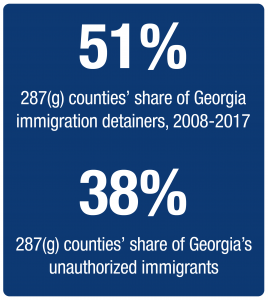 Counties that embrace more aggressive immigration enforcement arrest and detain more people, causing them to generate more of the detention and personnel costs described in the prior section. Over the past decade, Georgia’s four 287(g) counties accounted for 51 percent of immigrant detainers issued statewide, versus only 38 percent of the state’s total unauthorized population.[33]
Counties that embrace more aggressive immigration enforcement arrest and detain more people, causing them to generate more of the detention and personnel costs described in the prior section. Over the past decade, Georgia’s four 287(g) counties accounted for 51 percent of immigrant detainers issued statewide, versus only 38 percent of the state’s total unauthorized population.[33]- Law enforcement agencies with 287(g) agreements also bear more responsibilities than counties with more standard forms of cooperation, such as additional staff time and transporting detainees into federal custody. This increases the overall workload and can divert existing staff hours away from other public safety work, leading in some cases to employee overtime or the need to hire more officers.[34]
Though not all counties keep detailed records on the costs of Georgia’s 287(g) programs, available evidence suggests the price is likely substantial. In Gwinnett County, the state’s largest 287(g) program, budget figures obtained for this report[35] show the initiative carried about $9.8 million in direct costs over eight years from its inception in 2009 through 2016, or an average of $1.2 million a year.
These budget figures likely underestimate enforcement costs, since they include only the direct cost of administering the 287(g) program. Indirect costs likely also accrue, due to the same types of prolonged detention time and salary costs associated with detainers. A high-end estimate of Gwinnett County’s hyper-aggressive enforcement approach could reach up to $30 million over eight years, or $3.7 million a year on average.
 The immediate financial cost to Gwinnett County taxpayers likely falls somewhere between the high and low estimates, due to possible overlap between indirect costs of honoring detainers and the direct costs of administering 287(g). But the higher estimates are more are in line with the experience of 287(g) jurisdictions in other states.
The immediate financial cost to Gwinnett County taxpayers likely falls somewhere between the high and low estimates, due to possible overlap between indirect costs of honoring detainers and the direct costs of administering 287(g). But the higher estimates are more are in line with the experience of 287(g) jurisdictions in other states.
- In Virginia, the implementation of 287(g) in Prince William County led lawmakers to raise property taxes and tap their rainy-day fund to cover an estimated $6.4 million cost in year one and $26 million over five years.[36]
- In North Carolina, 287(g) cost Charlotte’s home county an estimated $5.5 million and Burlington’s home county an estimated $4.6 million in the first year.[37]
- And in the home county to Phoenix, Sheriff Joe Arpaio’s office generated a $1.3 million deficit in just three months after implementing 287(g), most of it due to employee overtime. The Arizona experience also illustrates the risk local governments run of potential litigation.[38] From 2007 to 2017, Maricopa County, home to Phoenix, spent almost $56 million defending the sheriff’s office against a racial profiling lawsuit.[39]
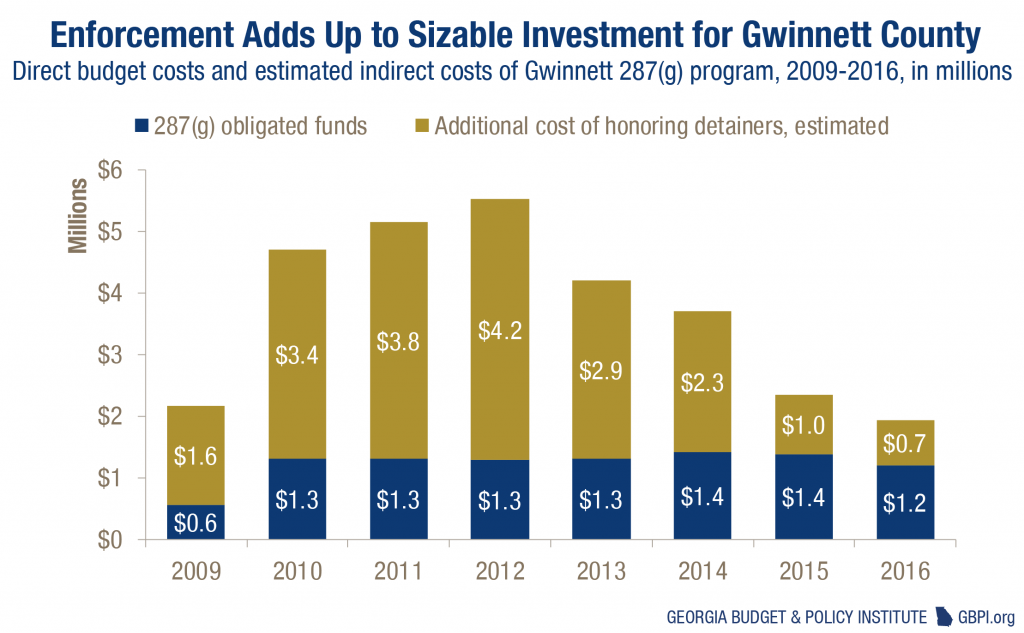
Most 287(g) Program Costs Aren’t Reimbursed
As with immigration detention costs overall, few of the costs for Georgia’s 287(g) programs are reimbursed by the federal government. While ICE covers some specific costs associated with starting 287(g) programs, local governments are responsible for the bulk of program expenses, especially salaries and benefits and other regular costs associated with arrest and detention.
The only true reimbursement for program expenditures comes through the SCAAP federal assistance program. GBPI analysis of these grants indicate Gwinnett County recovered no more than 10 percent of the cost of their 287(g) program since starting it in 2009. If the analysis is expanded to include the indirect costs of generating a high number of arrests and detainers, the county is reimbursed at just an estimated 3 percent rate.
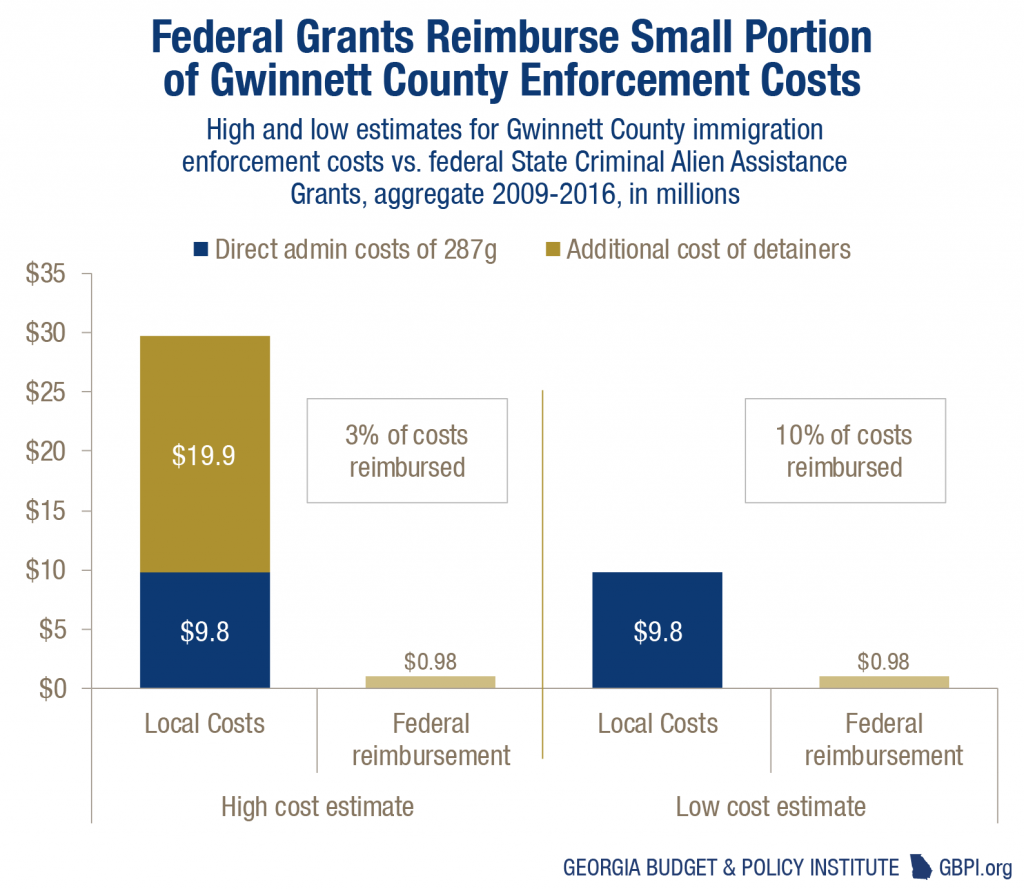
Some 287(g) counties may get a higher share of costs reimbursed than others, because localities can in some cases negotiate a daily stipend through a separate intergovernmental agreement with ICE. Available information indicates that Cobb and Whitfield counties receive daily per diems to offset a portion of 287(g)’s direct financial costs, whereas Gwinnett and Hall counties do not.[40]
Harm to Children and Families Likely Increases Future Costs
The true financial and economic cost to local governments probably exceeds these estimates in the long run, both for counties with a 287(g) program or more traditional forms of cooperation. That’s because detaining and deporting unauthorized immigrants carries associated costs to the community, such as the loss of household income and depressed spending power, which lowers the economic and tax contributions immigrant families are already making. This increases over the long haul, due to extreme socioeconomic and psychological harm to children who lose a parent or breadwinner.
Undocumented people are not only individuals but rather live as part of broader households that typically include a mix of unauthorized immigrants, legal permanent residents, naturalized citizens and U.S.-born citizen children. An estimated 226,000 Georgia children, 82 percent of whom are U.S. citizens, live in a home with at least one undocumented adult.
In Georgia’s four 287(g)-counties, the share of children living with an unauthorized immigrant in the home is 14 percent in Cobb, 18 percent in Gwinnett, 26 percent in Whitfield and 30 percent in Hall.[41]
 Unauthorized immigrants are in many cases the main or sole breadwinner for their household, so removing someone for driving without a license or some other minor infraction can create a financial disaster for families. National research indicates deporting an undocumented parent can reduce household income by as much as 70 percent.[42] The loss of livelihood is borne by the other household members, many of whom are American citizens or lawful residents. It also lowers economic activity and tax revenues and strains community social services.
Unauthorized immigrants are in many cases the main or sole breadwinner for their household, so removing someone for driving without a license or some other minor infraction can create a financial disaster for families. National research indicates deporting an undocumented parent can reduce household income by as much as 70 percent.[42] The loss of livelihood is borne by the other household members, many of whom are American citizens or lawful residents. It also lowers economic activity and tax revenues and strains community social services.
These consequences are especially sharp in counties with 287(g) agreements, according to one recent study. The table shows the estimated tax and economic contributions of households with at least one unauthorized immigrant in Georgia’s four 287(g) counties. Combined, mixed-status families in Cobb, Gwinnett, Hall and Whitfield contribute an estimated $288 million a year to Georgia in state and local taxes, according to the study.
Mixed-Status Families in Most Aggressive Enforcement Counties Make Sizable Contributions |
|||
| 287(g) Counties | Tax and economic contributions of households with unauthorized immigrants, in millions | ||
| Spending power | Federal tax contribution | State and local tax contribution | |
| Cobb | $722 | $156 | $85 |
| Gwinnett | $1,200 | $252 | $150 |
| Hall | $264 | $42 | $33 |
| Whitfield | $160 | $28 | $20 |
| TOTAL | $2,346 | $478 | $288 |
| Source: Center for American Progress | |||
Bad economic fallout is a particular risk in the long-run, due to dire consequences that family separation inflicts on children. Deporting a family member, especially a parent, can harm young people in ways that last for life. Research shows that when their parents are deported, children go through multiple negative experiences. They suffer from psychological trauma, especially when they witness a parent’s arrest.[43] Because their family is separated and in some cases loses its primary wage earner, they are likely to experience housing insecurity and economic instability.[44] Deportation can often leave children in the foster care system as well.[45]
“In 17 years, I’ve never seen this before. The stress is so high, they’re biting their fingers.”
– Georgia preschool director, describing children with immigrant parents, 2017[46]
Claims of Improved Public Safety Appear Dubious
Voluntary adoption of strict enforcement policies is often justified under the guise of protecting public safety, but available evidence suggests these claims are highly questionable. Indiscriminate immigration enforcement appears to poorly target violent crime, for one thing. A landmark 2011 study found that about half of people detained under local 287(g) programs nationwide were picked up for misdemeanors or ordinance violations such as speeding, driving without a license or public intoxication.[47] More recently, traffic offenses accounted for 70 percent of the charges leading to an immigration detainer in Gwinnett County from February to April 2017.[48]
Having local officers assume the role of federal immigration agents may also do more harm than good for public safety overall, since it undermines community trust between local residents and law enforcement agencies. Evidence indicates that unauthorized immigrants in hyper-enforcement jurisdictions are less likely to report crimes or provide police with useful tips, due to fear of deportation.[49] As the International Association of Chiefs of Police put it, “Local police agencies depend on the cooperation of immigrants, legal and [otherwise], in solving all sorts of crimes and in the maintenance of public order. Without assurances that they will not be subject to an immigration investigation and possible deportation, many immigrants with critical information would not come forward, even when heinous crimes are committed against them or their families.”[50]
Conclusion
In contrast to unproven claims about improving public safety, aggressive enforcement carries many known financial, economic and community costs. Heightened local enforcement incurs concrete expenses for detention and salaries, most of which aren’t reimbursed by the federal government. And loss of household income, psychological trauma for children and local officials’ risk of legal liability likely push the total price higher over time. These are among the reasons why local governments are increasingly moving to limit the ways they assume the role and risk of federal immigration enforcement. For example:
- The sheriff’s office in El Paso County, Colorado terminated its 287(g) agreement in 2015 after nearly eight years of operation, choosing to reallocate resources as part of a commitment to “fiscal responsibility and the strengthening of relationships with all citizens of the community.”[51]
- In Houston, Texas, the Harris County sheriff ended the local 287(g) program in February 2017, citing its estimated $675,000 in salary costs. He said those dollars could be better spent clearing backlogs at the local jails and targeting other high-priority public safety needs.[52]
- And in April 2018, Clarke County, Ga. cited concerns about the cost of potential litigation in announcing it will no longer honor detainer requests, unless accompanied by a “judicial warrant or an order from a court.”[53] Other Georgia jurisdictions including Clayton and DeKalb counties, and the cities of Clarkston and Decatur follow a similar approach.
Today, many of Georgia’s local governments are weighing whether to maintain, expand or limit their cooperation with voluntary aspects of federal immigration enforcement. State lawmakers could also soon consider legislation to make closer entanglement with federal practices mandatory, as they did during the 2018 General Assembly.[54] Public officials striving to chart the best course for their communities can carefully weigh the costs of aggressive enforcement against the doubtful benefits promised by supporters when choosing how to proceed.
Methodology
Though precise numbers on the cost of local enforcement of federal immigration policies are scarce, this report uses available information and the following methods to generate some informed estimates where possible.
Detainer costs
This report uses a methodology modeled after reports in other states, including Colorado and Washington, to estimate the potential costs of honoring detainers for Georgia’s local governments. Data on the number of detainers issued in Georgia comes from Syracuse University’s TRAC Immigration database. After compiling Georgia detainer data from 2003 to 2018 at the state, county and in some cases facility level, we limited our analysis to the 66,498 detainers issued for inmates at city and county jails from 2008 to 2017.
To generate a cost estimate, detainer data was combined with two additional pieces of information. First, information on the daily costs of housing inmates in Georgia from the Georgia Department of Corrections is included. Though jail costs vary by county, this report uses the state facilities’ estimate of $60.35 due to lack of available local data. Second, national research consistently indicates that immigrants with detainers are held longer than inmates without lawful status issues. Due to the apparent lack of Georgia or regional-specific data, this report uses the Colorado Fiscal Institute’s estimate of 22 extra days in custody for the typical inmate with an immigration detainer. These pieces of information are combined with the formula below.
| Local governments’ number of detainers, 2009-2017 | Estimated average cost per inmate, per day | Estimated additional days held per inmate | Estimated cost of honoring detainers, 2009-2017 |
| 66,498 | $60.35 | 22 | $88,289,395 |
| Source: GBPI analysis of Syracuse University TRAC Immigration database | Source: Georgia Department of Corrections, FY2016 Allocation of cost to inmates, probationers, etc. | Source: Colorado Fiscal Institute, “Misplaced Priorities: SB 90 and the Costs to Local Communities” |
287(g) costs
In June 2018, GBPI filed open records requests with the four Georgia counties that operated 287(g) programs since the late 2000s, requesting any county budget documents or financial analyses detailing the local costs of 287(g) enforcement. Only Gwinnett County provided detailed budget figures. The county’s response itemizes annual expenses for “Immigration and Customs Enforcement” as part of the broader sheriff department’s budget, from 2009 through the first half of 2018. The remaining three 287 (g) counties of Cobb, Hall and Whitfield reported not itemizing immigration enforcement costs within the county or sheriff department’s budget. Estimates for the indirect costs of 287(g) in Gwinnett reflect the county-specific cost of honoring detainers during that span, based on the same detainer methodology described above.
Federal reimbursement
The only consistent source of federal funding for local immigration enforcement is the State Criminal Alien Assistance Program (SCAAP). To estimate local governments’ reimbursement rate, this report compiled and analyzed SCAAP data from 2009 to 2016, the most recent year available. Excluded are payments to the Georgia Criminal Justice Coordinating Council, which administers SCAAP dollars for the state’s Department of Corrections.
Appendix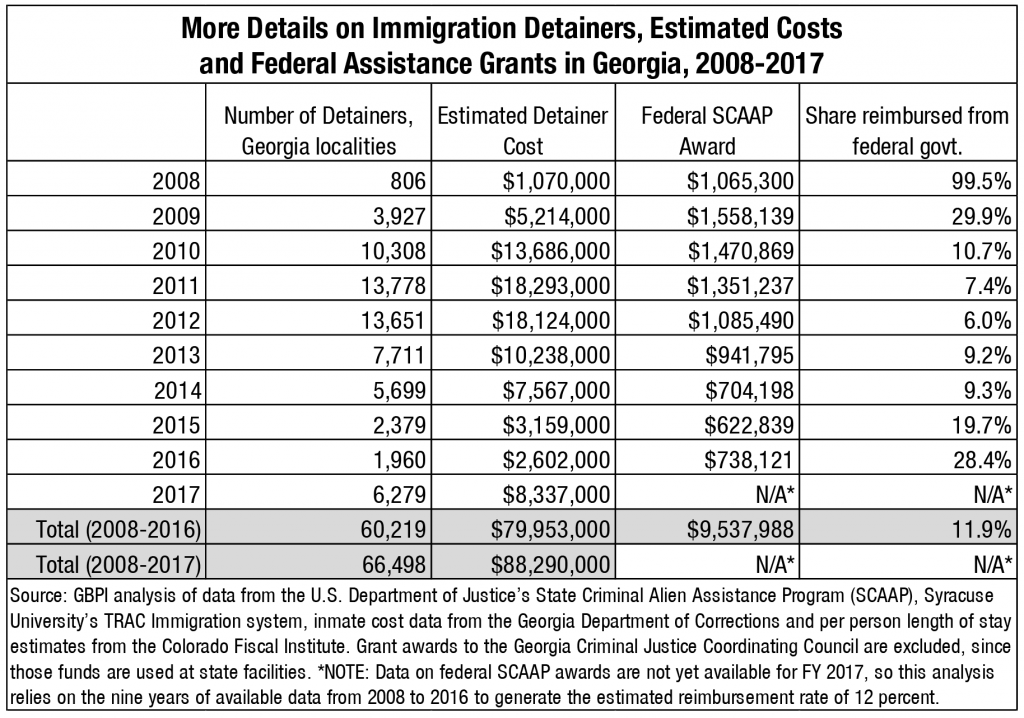

Endnotes
[1] In June 2018, GBPI filed open records requests with the four Georgia counties that have operated 287(g) programs since the late 2000s. The requests asked for any county budget documents or financial analyses detailing the local costs of 287(g) enforcement. Of the four, only Gwinnett County provided detailed budget figures. More details in Methodology section.
[2] GBPI analysis of 1990 U.S. Census and 2016 American Community Survey 1-year estimates.
[3] GBPI analysis of data from the Migration Policy Institute and 2016 American Community Survey (ACS) 1-year estimates. An estimated 59 percent of unauthorized immigrants live in five counties in Metro Atlanta and north Georgia—Gwinnett (20 percent), DeKalb (13 percent), Cobb (11 percent), Fulton (10 percent) and Hall (5 percent).
[4] “Profile of the Unauthorized Population: Georgia,” Migration Policy Institute. Accessed 7/16/2018.
[5] Immigration and Customs Enforcement (ICE) was created in 2003 as part of the organization of the new Department of Homeland Security. It was created by a merger of the Customs Service, the Immigration and Naturalization Service and the Federal Protective Service. See “History: Immigration and Customs Enforcement (ICE),” www.ice.gov/history
[6] “Revving Up the Deportation Machinery: Enforcement and Pushback under Trump,” Migration Policy Institute. 5/2018.
[7] Ibid.
[8] Ibid.
[9] “How Metro Atlanta Became a Pioneer of Immigration Enforcement,” NPR. 2/13/2018.
[10] ‘Please, God, Don’t Let Me Get Stopped’: Around Atlanta, No Sanctuary for Immigrants,” New York Times. 11/25/2017.
[11] “Secure Communities,” U.S. Immigration and Customs Enforcement (ICE). Accessed 7/16/2018.
[12] “Immigration Detainers: An Overview,” American Immigration Council. 3/21/2017.
[13] “Assumption of Risk: Legal Liabilities for Local Governments that Choose to Enforce Federal Immigration Laws,” American Immigration Council, et al. 3/2018.
[14] “The Role of Detainers Under Bush and Obama,” Syracuse University TRAC Immigration. 2/1/2016.
[15] Counties must request to participate in the program and receive federal approval, at which point local officials signed a Memoranda of Understanding with DHS outlining the specific requirements of all sides. Once a county enters the program, it can choose to terminate the agreement if it chooses at any time. All current 287(g) agreements are scheduled to expire in June 2019.
[16] “Georgia highly active in deportations,” Atlanta Journal-Constitution. 4/8/2012.
[17] “Delegation of Immigration Authority Section 287(g) Immigration and Nationality Act,” U.S. Immigration and Customs Enforcement. Accessed 7/16/2018.
[18] “Immigration enforcement program from ICE expanding in Georgia,” Potra Law Firm. 4/24/2018.
[19] “Prejudice, Policing and Public Safety: The Impact of Immigration Hyper-Enforcement in the State of Georgia,” ACLU of Georgia et al. 2014.
[20] “The 287(g) Program: An Overview,” American Immigration Council. March 2017.
[21] Ibid.
[22] Except where otherwise noted, all data in this report on the use of immigration detainers in Georgia derive from GBPI analysis of Syracuse University’s TRAC Immigration database. Further details available in methodology.
[23] See page 13 of “2017 Annual Report,” Texas Commission on Jail Standards. 2/1/2018.
[24] “Misplaced Priorities: SB 90 and the Costs to Local Communities,” Colorado Fiscal Institute. 12/1/2012.
[25] “Immigration Detainer Requests in King County, Washington: Costs and Consequences,” The University of Washington. 3/26/2013.
[26] “Driving while undocumented, and facing the risks,” New York Times. 7/18/2017.
[27] GBPI analysis of Hall County’s Freedom of Information Act (FOIA) response to Asian Americans Advancing Justice, dated 6/15/2017. “Minor traffic offenses” includes driving without a license, suspended license and failing a stop sign—driving under the influence is not included. This analysis covers 182 people who were arrested in Hall County and transferred to ICE from 1/27/2017 to 5/26/2017.
[28] “The Criminal Alien Program: Immigration Enforcement in Travis County, Texas,” American Immigration Council. 2/2010.
[29] “The Cost of Responding to Immigration Detainers in California,” Justice Strategies. 8/22/2012.
[30] “Misplaced Priorities: SB 90 and the Costs to Local Communities,” Colorado Fiscal Institute. 12/1/2012.
[31] “Immigration Detainer Requests in King County, Washington: Costs and Consequences,” The University of Washington. 3/26/2013.
[32] “Some of the costs of detention may be reimbursed by the federal government through the State Criminal Alien Assistance Program (SCAAP). However, the federal government has never fully funded SCAAP, and reimbursements only cover a fraction of the costs spent by states and localities.” “The 287(g) Program: An Overview,” American Immigration Council. March 2017.
[33] GBPI analysis of detainer data from Syracuse University’s TRAC Immigration System and estimates on Georgia’s unauthorized population from the Migration Policy Institute.
[34] “The 287(g) Program: An Overview,” American Immigration Council. March 2017.
[35] 10-year expenditures for the Gwinnett County Sheriff’s Department ‘Immigration and Customs Enforcement’ costs were obtained via an open records request in June 2018. More details in methodology.
[36] “Immigrants, Politics and Local Response in Suburban Washington,” Brookings Institution. 2/2009.
[37] “The Costs and Consequences of Local Immigration Enforcement in North Carolina Communities,” University of North Carolina. 2/2010.
[38] “Assumption of Risk: Legal Liabilities for Local Governments that Choose to Enforce Federal Immigration Laws,” American Immigration Council, et al. 3/2018.
[39] “287(g) Agreements Harm Individuals, Families, and Communities, but They Aren’t Always Permanent,” Center for American Progress. April 2018.
[40] Publicly available Memoranda of Understanding (MOAs) indicate that Cobb and Whitfield counties receive daily per diems of $42.58 and $41.03 respectively, whereas Gwinnett and Hall counties do not receive stipends.
[41] “What’s at Stake: Immigrant Impacts in 287(g) Jurisdictions,” Center for American Progress. 3/20/2018.
[42] “Implications of immigration enforcement activities for the well-being of children in immigrant families: A review of the literature,” Urban Institute and Migration Policy Institute. 2015.
[43] “Keeping Families Together: Why All Americans Should Care About What Happens to Unauthorized Immigrants,” Center for American Progress. 3/16/2017.
[44] “How Today’s Immigration Enforcement Policies Impact Children, Families, and Communities: A View from the Ground,” Center for American Progress. 8/2012.
[45] Ibid
[46] “Our Children’s Fear: Immigration Policy Effects on Young Children,” Center for Law and Social Policy (CLASP). 3/2018.
[47] “Delegation and Divergence: 287(g) State and Local Immigration Enforcement,” Migration Policy Institute. 2011.
[48] “Study: Gwinnett immigration enforcement soars under Trump Administration,” Gwinnett Daily Post. 5/27/2018.
[49] In Houston, reports of rape fell 43 percent among Latinos during the first three months after President Trump’s election, whereas reports among other groups dropped only 8 percent. See page 5 of “Revving Up the Deportation Machinery: Enforcement and Pushback under Trump,” Migration Policy Institute.
[50] “The 287(g) Program: An Overview,” American Immigration Council. March 2017.
[51] “Sheriff’s Office Ends 287(g) Immigration Enforcement Program,” El Paso County Sheriff’s Office. 5/1/2015.
[52] “Sheriff cuts ties with ICE program over immigrant detention,” Houston Chronicle. 2/21/2017.
[53] “Clarke County sheriff limiting cooperation with ICE amid crackdown,” Atlanta Journal-Constitution. 4/16/2018.
[54] Georgia lawmakers heavily debated a piece of legislation during the 2018 General Assembly – Senate Bill 452 – that would have required local governments to develop a close working relationship with ICE and to hand over almost any undocumented immigrant who came into local custody, regardless of severity of offense or length of tenure in the United States. For more details on SB 452, see “All Georgians Stand to Lose from Immigrant Crackdown Measure,” GBPI. 3/9/2018.









